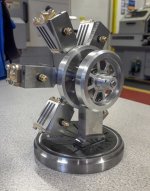Hi,
For the last 8 years I've worked in education, and I have access to the colleges lathes, mills and cnc shops (Bridgeports, Colchester/Harrisons and XYZ SMX and SLX).
I spend every free moment using and learning these machines, and I'm.......not as bad as I once was I've made a few projects like the engine that's pictured.
I've made a few projects like the engine that's pictured.
I'd like a career change, and I've been browsing around for a machinists job. Many of the jobs I see state "Must be able to work to 0.02mm ( 0.0007") tolerance"
Is that a standard thing? Some people I talk to say yes, others say "Anything needing that level of precision would be machined over size and ground to final spec".
I've tried working to 0.02 - I know I can't do it consistently !
Thanks,
For the last 8 years I've worked in education, and I have access to the colleges lathes, mills and cnc shops (Bridgeports, Colchester/Harrisons and XYZ SMX and SLX).
I spend every free moment using and learning these machines, and I'm.......not as bad as I once was
 I've made a few projects like the engine that's pictured.
I've made a few projects like the engine that's pictured.I'd like a career change, and I've been browsing around for a machinists job. Many of the jobs I see state "Must be able to work to 0.02mm ( 0.0007") tolerance"
Is that a standard thing? Some people I talk to say yes, others say "Anything needing that level of precision would be machined over size and ground to final spec".
I've tried working to 0.02 - I know I can't do it consistently !
Thanks,



